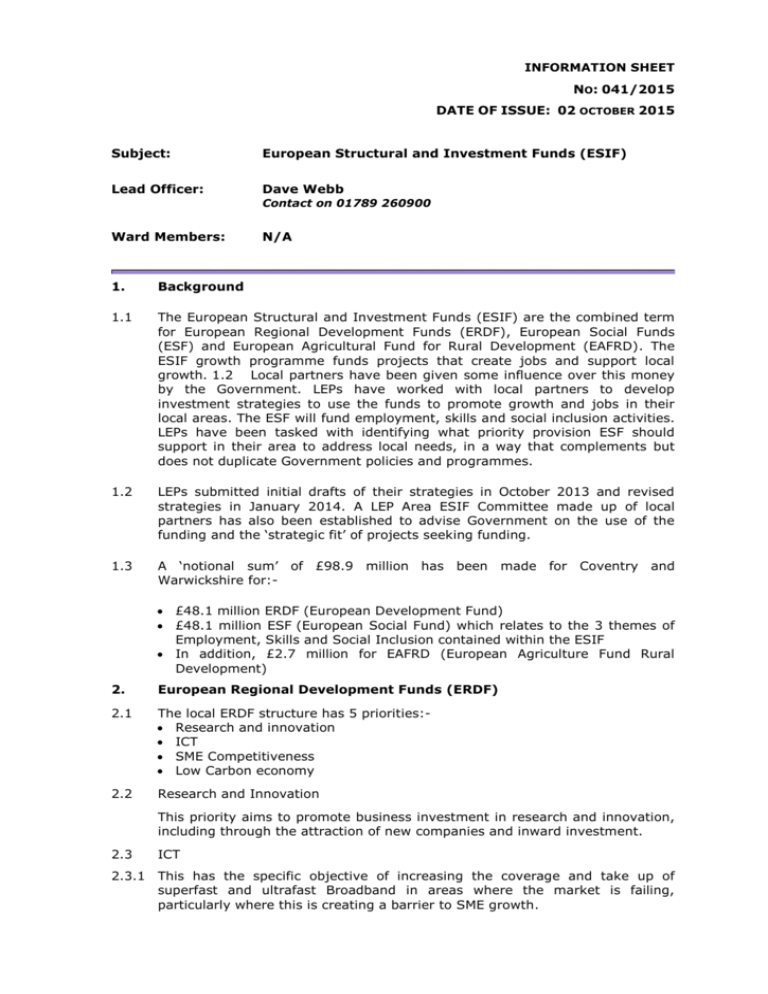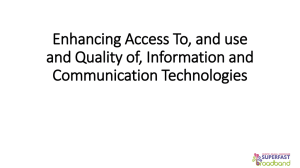European Structural and Investment Funds (ESIF)
advertisement

INFORMATION SHEET NO: 041/2015 DATE OF ISSUE: 02 OCTOBER 2015 Subject: European Structural and Investment Funds (ESIF) Lead Officer: Dave Webb Contact on 01789 260900 Ward Members: N/A 1. Background 1.1 The European Structural and Investment Funds (ESIF) are the combined term for European Regional Development Funds (ERDF), European Social Funds (ESF) and European Agricultural Fund for Rural Development (EAFRD). The ESIF growth programme funds projects that create jobs and support local growth. 1.2 Local partners have been given some influence over this money by the Government. LEPs have worked with local partners to develop investment strategies to use the funds to promote growth and jobs in their local areas. The ESF will fund employment, skills and social inclusion activities. LEPs have been tasked with identifying what priority provision ESF should support in their area to address local needs, in a way that complements but does not duplicate Government policies and programmes. 1.2 LEPs submitted initial drafts of their strategies in October 2013 and revised strategies in January 2014. A LEP Area ESIF Committee made up of local partners has also been established to advise Government on the use of the funding and the ‘strategic fit’ of projects seeking funding. 1.3 A ‘notional sum’ of £98.9 million has been made for Warwickshire for:- Coventry and £48.1 million ERDF (European Development Fund) £48.1 million ESF (European Social Fund) which relates to the 3 themes of Employment, Skills and Social Inclusion contained within the ESIF In addition, £2.7 million for EAFRD (European Agriculture Fund Rural Development) 2. European Regional Development Funds (ERDF) 2.1 The local ERDF structure has 5 priorities: Research and innovation ICT SME Competitiveness Low Carbon economy 2.2 Research and Innovation This priority aims to promote business investment in research and innovation, including through the attraction of new companies and inward investment. 2.3 ICT 2.3.1 This has the specific objective of increasing the coverage and take up of superfast and ultrafast Broadband in areas where the market is failing, particularly where this is creating a barrier to SME growth. 2.4 SME Competitiveness 2.4.1 Focuses upon the provision of advice, consultancy, mentoring and peer-to-peer support to indigenous businesses and inward investors (SMEs from outside the EU who will move to England). 2.4.2 This encompasses outreach, coaching, mentoring, networking and consultancy support to promote business start-up, survival and growth. Grants to support productive investment including the provision of non-grant finance to support start-ups or entrepreneurs where there is a clearly evidenced market failure. Provision of land and premises for employment sites including incubator space, managed workspace, or grow-on space. 2.5 Low Carbon economy 2.5.1 Covers R&D, innovation, supply chain work for low carbon technologies and materials, including carbon capture and carbon storage, wave and wind energy, smart grids, distributed generation, solar and photovoltaics, heat networks, heat pumps and low carbon heat for energy intensive industries. 3. European Social Fund (ESF) 3.1 Alcester, Stratford Avenue and New Town and Stratford Mount Pleasant are priority wards in ESF. Where possible we are asking for a target of 60% delivery in the 38 priority wards across Coventry & Warwickshire. 3.2 The ESF focuses on 3 thematic objectives: Promoting employment and supporting labour market mobility Promoting social inclusion and combating poverty Investing in education, skills and lifelong learning 3.3 Promoting sustainable/quality employment and supporting labour mobility 3.3.1 This is concerned with access to employment for jobseekers and economically inactive people, and on the sustainable integration of young people into the labour market, particularly those who are not in employment or training (NEET). Local priorities include: access to employment for jobseekers and inactive people sustainable integration of young people 3.4 Promoting social inclusion, and combating poverty 3.4.1 This priority is concerned with the active inclusion of disadvantaged people who are furthest from the labour market in order to improve their employability. It is intended to help remove barriers to work in a holistic and integrated way, including through supporting early action, outreach activities and access to locally provided services. Local priorities include: Increasing employability through financial literacy Tackling barriers to work Sustainable integration of young people 3.5 Investing in education, training and vocational training for skills and lifelong learning 3.5.1 This is concerned with improving access to lifelong learning, upgrading the skills and competences of the workforce, and increasing the labour market relevance of education and training systems. It will include support for intermediate, technical and higher level skills, and skills needed by SMEs, as well as helping low skilled people to progress at work. Local priorities: • Developing skills to tackle unemployment • Using skills to support and drive growth • Getting a better fit between education and employment 4. Supporting Tourism in rural areas 4.1 The RDP Growth Programme can fund a variety of investments in rural tourism to promote growth in the sector, including the development of businesses; support for visitor attractions and tourism infrastructure; and promoting local cooperation in order to develop and market tourism destinations. The aim is to support the creation of distinctive and high quality destinations, based on what each individual destination can offer. 4.2 LEPs and local partners have identified their key priorities for economic growth using ESIF funds within their ESIF strategies, including in many cases their local strategic priorities for investment in the tourism sector. 4.3 In providing advice to inform the development of EAFRD Growth Programme tourism Local ESIF sub-committees are encouraged to work with Destination Management Organisations (DMOs), where there is one established, to shape their advice to ensure that it is best suited to meeting local needs as set out in local Destination Management Plan (DMP). Where a DMO is not established, the Growth Programme can support the establishment of a DMO and the drawing up of a DMP. 4.4 Three measures are available to support tourism through the RDPE Growth Programme: 4.4.1 Support for investments in the creation and development of non-agricultural activities These grants are intended to help develop and grow existing rural tourism micro and small enterprises and help farms to diversify through rural tourism activities. Project applicants must demonstrate how their proposed activity brings about both direct economic benefits, for example job creation and visitor spend, but also how it contributes to development of the destination and wider rural growth. 4.4.2 Support for investments in visitor attractions, tourist information, recreational infrastructure and small scale infrastructure The grants are intended to help rural businesses and communities benefit from the value of tourism and attract visitors through activities and the management and development of rural assets including cultural, tourism and heritage amenities. 4.4.3 Co-operation for the development and marketing of tourism These grants are intended to support local co-operation and partnerships that improve the attractiveness of the destination, for example through developing the supply chain in the visitor economy and supporting businesses working together in the marketing and development of a destination. 5. Local impact 5.1 SME Competitiveness 5.1.1 Warwickshire County Council has submitted an outline application on behalf of partners. Stratford on Avon District Council is a delivery partner. The funding submission focuses upon gaps in provision, to complement rather than duplicate the activities of other partners and to build on some of the learning from current programmes. This is also guided by the findings of the subregional report ‘CW Business Support Review’ carried out by Regeneris Consulting. The £3.35 million project has been approved at outline and the full application will be submitted by the end of October. The project is part of a much wider £16 million Coventry and Warwickshire SME Growth Programme also involving Coventry City Council, the Growth Hub and other partners. 5.2 Broadband 5.2.1 The Coventry Solihull and Warwickshire team (CSW Broadband) has almost completed the rollout of Contract 1 under the BDUK programme. This was a £15.47m contract, to which Stratford District Council contributed £473,700. Under Contract 1 Stratford District will move from 45% to 75% superfast coverage. Contract 2, Part 1 will commence rollout later in 2015 and will continue to 2018. This is a £9.66m contract, funded by Warwickshire County Council and BDUK. Stratford will move from 75% superfast to around 89% superfast. Stratford District Council are being invited to contribute to Contract 2, Part 2 in order to take the superfast coverage still further. CSW Broadband is also in the process of applying for £3.8m ERDF. This application has also been approved at outline. 5.3 Other Projects 5.3.1 Warwickshire County Council are also a partner in two further projects: A £13.5m Coventry and Warwickshire Low Carbon Programme (which includes a cycling scheme in Stratford upon Avon) and a £5.1 million innovation project which will test emerging technologies and support collaboration between universities, SMEs and local authorities. 5.4 Social Inclusion 5.4.1 The local Social Inclusion Partnership is working to identify projects which may benefit from funding and submissions will be worked up in due course. 5.4.2 The Big Lottery Social Inclusion opt-in calls were launched and the outline application stage has now closed. Total value is approximately £7m split between £1.2m financial inclusion, £2.8m for young people (minimum £1.9m for Warwickshire) £3m tackling barriers to work. Delivery will need to cover the whole of Coventry and Warwickshire and will be 100% funded. Big Lottery received 10 applications for the Coventry & Warwickshire LEP area; 3 for financial capability, 4 for tackling barriers to work and 3 for sustainable integration of young people. 5.4.3 From the partnership events that CAVA organised we know we have a group of Citizens Advice Bureaux bidding for financial inclusion, both RightStep and the Groundwork have put themselves forward to lead on the young peoples' bid and CWCDA are leading a tackling barriers to work application. We do not have information on the other bidders at this point in time. 5.5 Rural Tourism 5.5.1 On behalf of the local tourism industry, Shakespeare’s England DMO is currently discussing opportunities to access funding to support rural tourism. A call for small-scale tourism infrastructure projects is open at the moment with a deadline of 30th October. A call for tourism co-operation projects was also published on 30th September with a deadline of 6th January 2016. 5.6 Employment and Skills 5.6.1 Calls for fully funded programmes for Skills and Employment are now not expected until the Autumn. These will also be large contracts across the whole of Coventry & Warwickshire. Invitations to tender expected to be worth £2.4m for the Employment theme commissioned by DWP and £7m for the Skills theme commissioned by the SFA, this will include £2.2m that is ring fenced for Warwickshire only. 5.7 Sustainable integration of young people 5.7.1 There will also be a specific open call for projects to support young people in Warwickshire. This is because Coventry is eligible for additional funding under the Youth Employment Initiative which Warwickshire is not. This call will be worth £1.5m and will need to be 50% match funded. Dave Webb HEAD OF ENTERPRISE, HOUSING AND REVENUES






